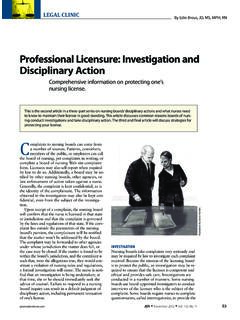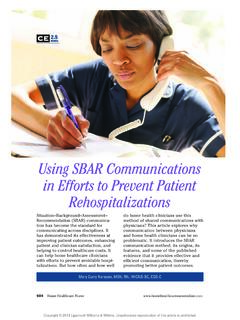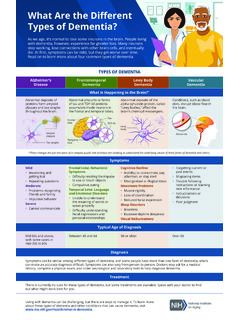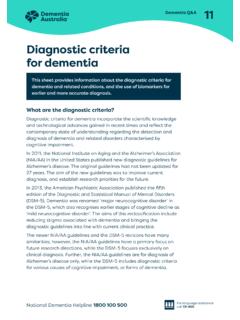Transcription of StrategieS for feeding PatientS with dementia
1 In the United States, nearly 14% of people over the age of 71 have some form of People with dementia constitute roughly 25% of hospital PatientS ages 65 and older2 and 47% of nursing home And more than half of them lose some ability to feed themselves,4 which puts them at high risk for inadequate food in take and malnutrition. PatientS who are unable to eat in dependently must rely on caregivers to assist them phy sically or with verbal prompts or cues during meal times. Unfortunately, caregivers may be unable to iden tify the various types of feeding problems that accompany dementia or unaware of the feeding prac tices required to address nursing assistants (CNAs) provide nearly all feeding assistance in long term and acute care set tings. Although they re trained in basic feeding tech niques, CNAs may be unprepared for the challenges that arise when assisting people with dementia or fail to realize how the cognitive impairments associated with dementia may, in an institutional setting, be ex ac erbated by physical, psychological, social, envi ronmental, or cultural Although CNAs are taught the skills to deal with specific feeding difficul ties,6, 7 they must rely on nurses to assess particular 36 AJN April 2011 Vol.
2 111, No. 4 By Chia-Chi Chang, PhD, RN, and Beverly L. Roberts, PhD, FAAN, FGSAS trategieS for feeding PatientS with dementiaHow to individualize assessment and intervention based on observed : Despite the high prevalence of dementia among elderly PatientS in hos pitals and nursing homes and the strong association between dementia and feeding difficulty, few sources adequately address effective feeding interventions. Basing their discussion on the conceptual model that grew out of a previously published systematic literature review, the authors address a wide range of assessment and intervention practices specific to various observed behaviors that may aid in feed ing PatientS with : Alzheimer s disease, demen tia, feeding difficulties, malnutritionFeeding Evaluation in dementia (EdFED), the feeding Behaviors Inventory, and the Eating Behavior Scale (EBS).
3 The EdFED8 12 is an 11 item assessment tool de signed to help clinicians determine the level of feed ing assistance PatientS need based on observed eat ing and feeding problems. The feeding Behaviors In ven tory13 directs clinicians to assess PatientS for 33 com mon, problematic mealtime behaviors associated with Alzheimer s disease in order to develop appropriate, individualized nursing care plans. The EBS14, 15 was de veloped by clinical nurses at the National Institutes of Health to help providers measure the functional abil ity of PatientS with Alzheimer s disease to perform six general eating behaviors. Our analysis re vealed that, while the EdFED was an aid in assessing feeding dif ficulties, it didn t address many aspects of the com mon feeding difficulties in dementia (such as difficulty getting food into the mouth, chewing, swallowing, or pay ing attention to the task of eating); the Feed ing Be haviors Inventory included more behaviors than the EdFED but failed to address antecedents or situations and guide them in how to article provides an overview of the feeding dif ficulties associated with dementia and suggests ways that caregivers might intervene to overcome them.
4 We developed the conceptual model for the assessment and intervention StrategieS presented here after com pleting a comprehensive systematic literature review, which was published In conducting that re view, we used concept analysis to characterize feeding difficulties associated with dementia and to identify their antecedents (contributing factors) and conse quences (outcomes) (see Figure 1). Although the strat egies we formulated based on that review and analysis may be used by family caregivers, this article focuses on tactics that formal caregivers can use in hospital or nursing home feeding DIFFICULTIESIn our previously published review,5 we evaluated three instruments commonly used to measure feeding difficulties in PatientS with dementia : the Edinburgh Green House facilities, such as the one shown in this photo, prepare meals in a homelike, open kitchen and serve residents at a large din ing table where they can social ize with staff and visitors.
5 Photo by Rollin Riggs / New York Times / Redux AJN April 2011 Vol. 111, No. 4 3738 AJN April 2011 Vol. 111, No. 4 hygiene, may contribute to chewing difficulties, and ineffective chewing may exacerbate dysphagia, which is associated with gagging, coughing, and aspi ration, in addition to poor nutrition. Psychological and social issues. The prevalence of depression in dementia is estimated to be roughly 45%, both in long term care facilities and in the com , 17 In PatientS with dementia , changes in func tional or mental status and reports of pain may signal the onset of depression,18 which can take the form of refusing food or feeding assistance, becoming with drawn, or displaying aggression. Furthermore, some of the medications prescribed to treat depression and other psychological disorders (such as aggression, de lusions, or hallucinations) may complicate feeding by producing somnolence or agitation.
6 Environmental factors. The dining environment plays an important part in the feeding In din ing rooms that are crowded and full of environ mental distractions such as loud background noises, so cial conversations among staff, and very vocal or noisy diners, clinicians have observed that PatientS are impatient, agitated, and tend to have feeding prob Unfortunately, institutional mealtime environ ments are very often crowded, chaotic, and noisy, with frequent interruptions or distractions and trays often placed out of PatientS considerations. If the caregiver provid ing feeding assistance has different cultural expectations from those of the patient, it may reduce the quality of the patient s dining experience as well as the patient s food For example, in the Korean culture, ol der adults both expect and are expected to become dependent as a part of normal Such cultural expectations may affect not only the expression and identification of feeding difficulties but also the StrategieS consequences of feeding difficulties.
7 And, while the EBS identified important types of feeding difficulties, it provided no observational criteria for determining whether the behaviors were CONTRIBUTING FACTORSIn discussing the feeding difficulties associated with de mentia, it s important to first consider their anteced ents the factors that contribute to these cognitive function. dementia is associ ated with a progressive decline in short and long term memory, attention, and executive function. Initially, the only cognitive impairment may be a short term memory deficit, which interferes with eating because it causes the patient to forget the task at hand or be come easily distracted. As dementia progresses, impairments such as apraxia (the impaired ability to perform skilled or purposeful movements) and agnosia (the impaired recognition or comprehension of sensory stimuli) of ten emerge.
8 Apraxia can interfere with PatientS ability to use eating utensils, while agnosia can impair their ability to recognize food and know what should be done with dysfunction. Older adults commonly lose some of the fine motor skills required to get food from the plate into the mouth. In addition, altered smell and taste may reduce their appetite and food intake, while comorbid visual impairments may make it difficult for them to see food and utensils (particularly when there s little contrast between the table, the plate, and the food). Compounding these problems, people with dementia resulting from vascular changes in the central nervous system often lose the ability to control and co ordinate chewing and swallowing. Dental problems (including poorly fitted dentures; missing, loose, or de cayed teeth; and dental sensitivity), as well as poor figure 1.
9 Model of feeding difficultieSAdapted with permission from Chang CC, Roberts BL. feeding difficulty in older adults with dementia . J Clin Nurs 2008;17(17) of social interaction Perceptual deficitsPoor motor controlCognitive impairmentPsychological factorsPoor dining environment Culturally inappropriate food choicesFeeding DifficultiesDifficulty initiating feeding tasks Difficulty maintaining attention to feeding task Difficulty getting food into the mouthDifficulty chewing foodDifficulty swallowing foodConsequencesInadequate food intake Weight lossMalnutritionAspirationPulmonary AJN April 2011 Vol. 111, No. 4 39and providing adequate space for the feeder to sit down and have eye contact with the patient encour ages interaction between the some long term care settings, there have been significant efforts to make the dining environment as homelike as possible.
10 For example, facilities modeled after the Green House concept prepare meals in an open kitchen and serve them at a large dining table at which residents can socialize with staff and Typically, meals are accompanied by soft music, ta bles are set with flowers, and mealtimes last for more than an hour. Similarly, the Eden Alternative strives to create a small homelike environment that enhances so cial interaction and supports the autonomy of resi In Eden homes, residents have 24 hour open ac cess to snack foods of their choosing. Family style meals, which recreate a homelike atmosphere by al lowing residents to sit with each other at the dinner ta ble and select food from serving bowls placed on the table, have been found to increase resident participa tion, appropriate communication at mealtimes, and the frequency of praise by CNAs assisting with feed , 32 It s been suggested that increasing the aro ma of food preparation in the dining room may also re duce mealtime Research on the effects of these changes on eating behavior and caloric intake is room music has been used in some sett ings to increase food intake,34 and it s thought to in crease con centration and decrease agitated behavior,35 37 though findings have been inconsistent.
















